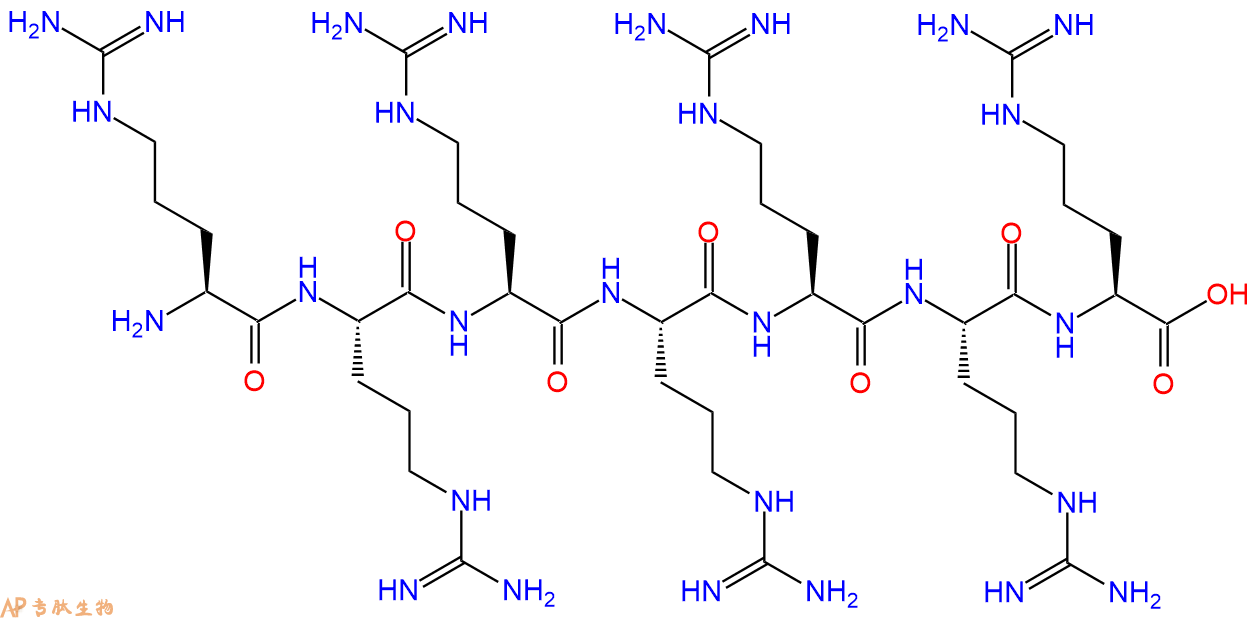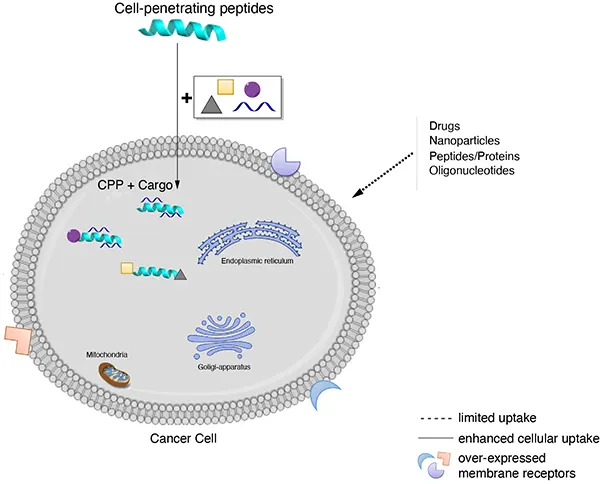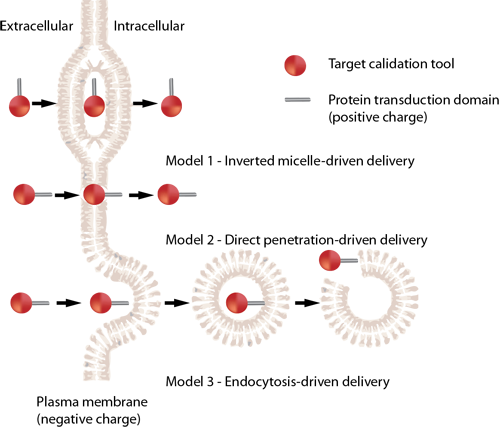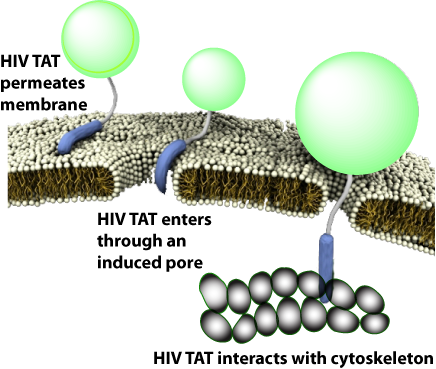
七精氨酸作为精氨酸低聚物,无论是单独的还是与治疗剂或大型生物聚合物偶联时,都已显示出易于穿过各种生物膜(例如脂质双层和上皮组织)。
编号:128769
CAS号:165893-48-1
单字母:H2N-RRRRRRR-OH
| 编号: | 128769 |
| 中文名称: | 七聚精氨酸肽、Arg7、R7、(Arg)7 |
| 英文名: | Cell penetrating peptide R7、Arg7、R7、(Arg)7 |
| 英文同义词: | H(-Arg)₇-OH, Heptaarginine |
| CAS号: | 165893-48-1 |
| 单字母: | H2N-RRRRRRR-OH |
| 三字母: | H2N N端氨基 -Arg精氨酸 -Arg精氨酸 -Arg精氨酸 -Arg精氨酸 -Arg精氨酸 -Arg精氨酸 -Arg精氨酸 -OHC端羧基 |
| 氨基酸个数: | 7 |
| 分子式: | C42H86N28O8 |
| 平均分子量: | 1111.32 |
| 精确分子量: | 1110.72 |
| 等电点(PI): | - |
| pH=7.0时的净电荷数: | 7.97 |
| 平均亲水性: | 3 |
| 疏水性值: | -4.5 |
| 外观与性状: | 粉末状固体 |
| 消光系数: | - |
| 来源: | 人工化学合成,仅限科学研究使用,不得用于人体。 |
| 纯度: | 95%、98% |
| 盐体系: | 可选TFA、HAc、HCl或其它 |
| 生成周期: | 2-3周 |
| 储存条件: | 负80℃至负20℃ |
| 标签: | 细胞穿膜肽(Cell permeable peptides, CPPs) |
七精氨酸作为精氨酸低聚物,无论是单独的还是与治疗剂或大型生物聚合物偶联时,都已显示出易于穿过各种生物膜(例如脂质双层和上皮组织)。鸟嘌呤基团在转运中的重要性得到了以下观察结果的支持:精氨酸的短寡聚物进入细胞的速度远远快于赖氨酸、组氨酸、鸟氨酸或瓜氨酸的相应寡聚物。
Arginine oligomers as heptaarginine, either alone or when conjugated to therapeutic agents or large biopolymers, have been shown to cross readily a variety of biological membranes (e.g. lipid bilayers and epithelial tissue). The importance of the guanidinium group in transport was supported by the observation that short oligomers of arginine entered cells far more rapidly than the corresponding oligomers of either lysine, histidine, ornithine, or citrulline.
单独或与治疗剂或大型生物聚合物组合的H-Arg-Arg-Arg-Arg-Arg-OH已被证明可以容易地穿过各种生物膜(例如脂质双层和上皮组织)。鸟嘌呤基团在转运中的重要性得到了以下观察结果的支持:精氨酸的短寡聚物进入细胞的速度远远快于赖氨酸、组氨酸、鸟氨酸或瓜氨酸的相应寡聚物。
H-Arg-Arg-Arg-Arg-Arg-Arg-Arg-OH, either alone or in combination with therapeutic agents or large biopolymers, has been shown to easily cross a variety of biofilms (e.g. lipid bilayers and epithelial tissue). The importance of the guanidinium group in transport is supported by the observation that short oligomers of arginine enter cells far more rapidly than the corresponding oligomers of either lysine, histidine, ornithine or citrulline.
细胞穿膜肽-说明
穿透细胞膜进入细胞内是许多作用靶点在细胞内的生物大分子发挥作用的先决条件,然而生物膜的生物屏障作用阻止了许多高分子物质进入细胞内,从而很大程度地限制了这些物质在治疗领域的应用。因此,如何引导这些物质穿透细胞膜是一个迫切需要解决的问题,目前介导生物大分子穿透细胞膜的方法主要包括细胞穿透肽(cell penetrating peptides,CPPs)、脂质体、腺病毒、纳米颗粒、影细胞等,而CPPs是一类以非受体依赖方式,非经典内吞方式直接穿过细胞膜进入细胞的多肽,它们的长度一般不超过30个氨基酸且富含碱性氨基酸,氨基酸序列通常带正电荷。
1型人免疫缺陷病毒转录激活因子TAT(human immunodeficiency virus-1 transcription activator, HIV-1 TAT)是第一个被发现的细胞穿透肽,它凭借一种无毒的、高效的方式进入细胞。
细胞穿透肽(cell penetrating peptides,CPPs)的一个重要特点是可以携带多种不同大小和性质的生物活性物质进入细胞,包括小分子化合物、染料、多肽、多肽核酸(peptide nucleo acid, PNA)、蛋白质、质粒DNA、siRNA、200nm的脂质体、噬菌体颗粒和超顺磁性粒子等,这一性质为其成为靶向药物的良好载体提供了可能。
CPPs作为载体的优势在于低毒性和无细胞类型的限制,尽管CPPs可输送不同类型的物质进入细胞,但其实际应用多集中于寡肽、蛋白质、寡聚核苷(oligonucleotides,ONs)或类似物的细胞转运。

跨膜机理
不同的细胞穿透肽(CPP)跨膜机制不同,一个细胞穿透肽(CPP)的具体机制有赖于几个参数,如分子大小(携带物质)、温度、细胞类型和细胞内外的稳定性等。细胞穿透肽(CPP)进入细胞的具体机制目前还不清楚,比较流行的推测包括以下三种:
A: 倒置胶粒模型(inverted micelle model),CPPs通过细胞膜上磷脂分子的移动形成倒置胶粒结构,而进入胞浆。
B: 直接穿透,即孔隙结构模型 (pore formation model),CPPs在细胞膜上组成跨膜的孔隙结构而进入胞浆 。
C: 内吞方式进行细胞摄取。
来源: Cell-penetrating peptides and their therapeutic applications, Victoria Sebbage, BioscienceHorizons, Volume 2, Number 1, March 2009.

细胞穿透肽 HIV TAT
细胞穿透肽(如HIV TAT)可以以直接穿透和内吞两种方式进入细胞。HIV TAT或者简单的多聚精氨酸可被设计作为有效的药物载体,但CPP(如HIV TAT)是如何实现胞膜转运,目前仍不清楚。
简单的HIV TAT是如何促进象直接穿透和内吞作用的入胞机制的呢?来自Gerard Wong实验室的研究人员研究了在不同的条件下,HIV TAT是如何与细胞质膜、细胞骨架、特异的胞膜受体相互作用,从而诱导了多重转运途径。

有趣的是,TAT在不同条件下可与同一序列发生多种不同的反应,因而与胞膜、细胞骨架、特异受体相互作用可产生多种转运途径。
CPP的跨膜机制与多肽序列存在很敏感的关系,如果在一个纯亲水性的CPP中增加一个疏水残基,就能彻底地改变其转运机制,例如,最简单的CPP原型-多聚精氨基(polyR),可以诱导细胞膜上形成跨膜的孔隙结构。疏水氨基酸通过插入胞膜来形成正曲率,精氨酸可同时形成正曲率和负曲率,赖氨酸只能沿一个方向形成负曲率,这就意味着在精氨酸与赖氨酸/疏水物之间存在补偿关系。
如果疏水性有助于形成负高斯曲率(Gaussian curvature),那为什么TAT肽中的疏水含量相对较低呢?其原因是CPPs都是利用尽可能少的疏水基去形成saddle-splay curvature。序列上的差异很可能只会在膜上诱导短暂的类似孔隙的跨膜结构,从而形成对CPP来说更短的孔隙寿命。由于CPP的氨基酸组成不同,TAT肽在有或无受体情况下都可以介导细胞内吞作用。
专肽生物提供各类细胞穿膜肽序列,部分由现货,例如TAT,R8,R4等,具体可咨询销售人员。
Definition
Cell permeable peptides (CPPs) are carriers with small peptide domains that can freely cross cell membranes. They are mainly used as carriers of proteins and nucleic acids into the cell1.
Discovery
The first CPP was discovered independently by two laboratories in 1988 when it was found that the trans-activating transcriptional activator (Tat) from Human Immunodeficiency Virus 1 (HIV-1) could be efficiently taken up from the surrounding media by numerous cell types in culture2.
Structural Characteristics
CPPs typically have an amino acid composition containing either a high relative abundance of positively charged, cationic amino acids such as lysine or arginine, or have sequences that contain an alternating pattern of polar/charged amino acids and non-polar, hydrophobic amino acids3. Some examples include: TAT peptide-YGRKKRRQRRR, lipid membrane translocating peptide-KKAAAVLLPVLLAAP and Antennapedia leader peptide-KKWKMRRNQFWVKVQRG.
Classification
Numerous CPPs have been identified to date and they belong to a wide variety of protein families. For example, some CPPs are amphipathic protein family members3.
Mode of action
CPPs enter the cell with their carrier by either of three mechanisms: Direct delivery that involves energy independent entry of the CPPs in to the cell4, endocytosis where the cells take up the CPPs by imbibing them with their cell membranes5 and translocation through the formation of transient structures which is yet to be understood6.
Functions
CPPs have found numerous applications in medicine as drug delivery agents in the treatment of different diseases including cancer, virus inhibitors, contrast agents for cell labeling a classical example is Green Fluorescent protein GFP, as MRI contrast agents, quantum dots7. TAT is very effective in delivering drugs in vitro and in vivo and so far a peptide that matches its efficiency has not been found7.
References
1. Wagstaff KM and David JA (2006). Protein Transduction: Cell Penetrating Peptides and Their Therapeutic Applications, Current Medicinal Chemistry, 13 (12), 1371-1387.
2. Feng S and Holland EC (1988). HIV-1 Tat trans-activation requires the loop sequence within Tar. Nature 334, 165–167.
3. Stewart KM, Horton KL, Kelley SO (2008). Cell-penetrating peptides as delivery vehicles for biology and medicine, Org Biomol Chem., 6(13), 2242-55.
4. Luo D, Saltzman WM (2000). Synthetic DNA delivery systems. Nat. Biotechnol, 18, 33-37.
5. Lundberg M., Wikstrom S and Johansson M (2003). Cell surface adherence and endocytosis of protein transduction domains, Mol. Ther., 8, 143–150.
6. Deshayes S, Gerbal-Chaloin S, Morris MC, Aldrian-Herrada G, Charnet P, Divita G (2004). On the mechanism of non-endosomial peptide-mediated cellular delivery of nucleic acids, Biochim. Biophys. Acta, 1667, 141–147.
7. Temsamani J and Vida P (2004). The use of cell-penetrating peptides for drug delivery, Drug Discovery Today, 9 (23), 1012-1019.
| DOI | 名称 | |
|---|---|---|
| 10.1021/jm0105676 | Arginine-rich molecular transporters for drug delivery: role of backbone spacing in cellular uptake | 下载 |
| 10.1016/j.bbrep.2017.06.007 | Peptide translocation across MOMP, the major outer membrane channel from Campylobacter jejuni | 下载 |





